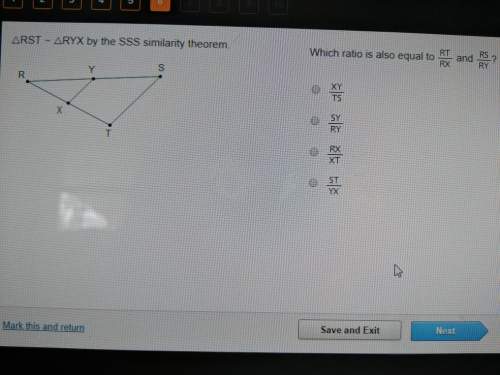Which of these is a statistical question?
A. How tall is the Willis Tower?
B. How many times...

Mathematics, 12.04.2021 23:50 graceshort7orepzg
Which of these is a statistical question?
A. How tall is the Willis Tower?
B. How many times has Mark visited the Willis Tower?
C. How many people visit the Willis Tower each day?
D. How tall is Mark?

Answers: 3


Another question on Mathematics

Mathematics, 21.06.2019 18:40
Juliana says that she can use the patterns of equivalent ratios in the multiplication table below to write an infinite number of ratios that are equivalent to 6: 10. which statement explains whether juliana is correct? she is correct because she can multiply 6 and 10 by any number to form an equivalent ratio. she is correct because 6: 10 can be written as 1: 2 and there are an infinite number of ratios for 1: 2. she is not correct because the multiplication table does not include multiples of 10. she is not correct because 6: 10 is equivalent to 3: 5 and there are only 9 ratios in the multiplication table that are equivalent to 3: 5.
Answers: 1

Mathematics, 22.06.2019 00:00
If 7x=9y, y/z = 7/5 , then x/z = (a) 2/7 (b) 7/9 (c) 9/5 (d) 9/7 (e) 5/9
Answers: 1

Mathematics, 22.06.2019 00:30
Officer brimberry wrote 32 tickets for traffic violations last week, but only 4 tickets this week. what is the percent decrease? give your answer to the nearest tenth of a percent.
Answers: 1

Mathematics, 22.06.2019 02:00
Study published in the journal of personality and individual differences found that adults with adhd displayed more creative achievement than those who didn't have the disorder. "for the same reason that adhd might create problems, like distraction, it can also allow an openness to new ideas," says holly white, assistant professor of cognitive psychology. "not being completely focused on a task lets the mind make associations that might not have happened otherwise." white and priti shah at the university of michigan gave 60 college students – half of them with adhd – a series of tests measuring creativity across 10 domains. the adhd group scored higher across the board. the adhd group showed more of a preference for brainstorming and generating ideas than the non-adhd group, which preferred refining and clarifying ideas. the adhd status of the participants was established by asking whether the individual had ever been clinically diagnosed with adhd/add. the tests of creativity were pencil-and-paper tasks administered in a laboratory setting. each of the ten scales was comprised of multiple questions, the scores on which were summed (e.g., writing creativity: "how many words can you make from the letters in the word 'psychology' invention creativity: "write down as many uses for a paper clip that you can think of.") this procedure does allow for a participant to be scored as showing no creativity under these conditions. a) state the research question in plain language (i wonder if is related to (1 point) b) state the null hypothesis (1 point) c) state the research hypothesis (1 point) d) is the research hypothesis directional or non-directional (1 point) e) name the predictor / independent variable f) give the operational definition of the predictor / independent variable g) evaluate the construct validity of the predictor / independent variable. (face, procedure, method-match) h) name the outcome / dependent variable i) give the operational definition of the outcome / dependent variable. j) evaluate the construct validity of the outcome / dependent variable. (face, procedure, method-match)
Answers: 1
You know the right answer?
Questions

Mathematics, 23.01.2020 19:31

Mathematics, 23.01.2020 19:31

Mathematics, 23.01.2020 19:31

English, 23.01.2020 19:31




Computers and Technology, 23.01.2020 19:31

Computers and Technology, 23.01.2020 19:31

History, 23.01.2020 19:31



Chemistry, 23.01.2020 19:31

Mathematics, 23.01.2020 19:31

Business, 23.01.2020 19:31



Chemistry, 23.01.2020 19:31

Biology, 23.01.2020 19:31




